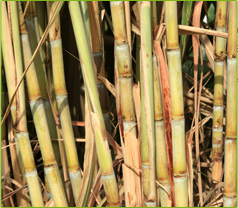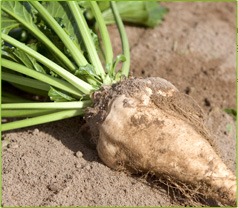Sugar beet & sugar cane
Where does sugar come from?
Sugar comes from either sugar cane or sugar beet with the climate of a geographical region being the prime influence on which is grown.
In both cases, the juice is extracted from the sugar beet or cane and impurities are removed. It is then crystallised into white sugar, which is 99.95% sucrose. Sugar is identical whether it comes from beet or cane.
Sugar Cane

Sugar cane is a relative of ordinary grass and grows to five metres in height.
It is found in the tropical and semi-tropical climates of the world. This part of the world is hot and sunny all year and has heavy seasonal rainfall – conditions in which the plant thrives. Just under half of Britain’s sugar comes from this source.
Farming sugar cane
Sugar cane is mainly grown on large farms called plantations. Before cane can be grown the land is prepared by ploughing. Short selections of cane called “setts” are planted and new shoots and roots grow from ‘eyes’ in the sett. After planting, the crop is sprayed with water and fertilizer. A single sett can produce up to seven crops.
It takes between 11 and 18 months for the cane to produce enough sugar for the crop to be ready for harvesting. In the past nearly all cane sugar was harvested by hand using large knives called ‘machetes’. Today many plantations use special machinery to harvest crops. When the cane is harvested it has a sugar content of about 12%. The roots are left in the ground as they will eventually sprout and grow to form the next crop. The new canes are called ratoons.
Once the cane is cut it is sent to the sugar cane mill for processing into raw sugar. This has to be done quickly as the crop soon begins to deteriorate in the warm, damp climate. See Production of Sugar for further details.
Sugar Beet

Sugar beet is a large pale brown root crop similar to the parsnip, and has a sugar content of 16% when it is harvested. It grows in the temperate climate of Europe and North America.
Growing sugar beet
Preparing the fields for sugar beet begins as early as the autumn when the soil is tested to see if phosphate, potassium and sodium need to be applied before ploughing. Sometimes lime is spread on the fields to ensure that the soil is not too acidic. Sowing generally takes place in late March and early April. Nitrogen fertilizer is applied at this time to help the crop grow, and specialist herbicides may be sprayed over the fields to stop weeds growing.
Timing is critical in the growing of sugar beet and harvesting takes place towards the end of the year when the amount of sugar in the beet is at its highest. A delay in harvesting can prove very costly to the farmer as sugar beet is easily damaged by frost, therefore harvesting is finished as quickly as possible.
Harvesters cut off the top leaves of the sugar beet and these are used as animal feed for cattle and sheep or are ploughed back into the land as a natural fertilizer. The root of the beet is cleaned to remove any soil attached to it before being delivered to the factory. Because beet is a heavy and bulky crop, transport distances are kept as short as possible to reduce costs and sugar factories are generally built in the beet growing areas on the edge of large towns which can provide the workforce.
Read about global sugar production figures